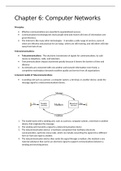Chapter 6: Computer Networks
Principles:
Effective communications are essential to organizational success.
Communications technology lets more people send and receive all forms of information over
great distances.
The Internet is like many other technologies – it provides a wide range of services, some of
which are effective and practical for use today, others are still evolving, and still others will fade
away from lack of use.
Telecommunications:
Telecommunications: The electronic transmission of signals for communications, by such
means as telephone, radio, and television
Telecommunications impacts businesses greatly because it lessens the barriers of time and
distance
As networks are connected with one another and transmit information more freely, a
competitive marketplace demands excellent quality and service from all organizations
A General model of Telecommunications
A sending unit such as a person, a computer system, a terminal, or another device, sends the
message signal to a telecommunications device.
1. The model starts with a sending unit, such as a person, computer system, a terminal or another
device, that originates the message.
2. The sending unit transmits a signal to a telecommunication device
3. The telecommunication device- a hardware component that facilitates electronic
communication- performs many tasks, which can include converting the signal into a different
form or from one type to another.
4. The telecommunication device then sends the signal through a medium, this medium is any
material substance that carries an electronic signal to support communications between a
sending and receiving device.
, 5. Another telecommunication device connected to the receiving computer receives the signal.
6. The process can be reversed, and the receiving unit can send an0ther message to the original
sending unit (1).
The speed of which information is transmitted, is measured in bits per second (bps) common
speeds range from thousand (kbps) to millions (Mbps) and billions (Gbps)
Synchronous and Asynchronous Communication
o Advances in telecommunications technology allow us to communicate rapidly with
clients and co-workers almost anywhere in the world.
With synchronous communication, the receiver gets the message almost
instantaneously, when it is sent such as a phone call, you need two channels
running in parallel.
With asynchronous communication (such as e-mail) there is a measurable delay
between the sending and receiving of the message, sometimes hours or even
days. One channel, people talk over one another.
Telecommunication Media Types
o Wireless Transmission
Microwave: Terrestrial and satellite
3G, 4G and 5G wireless communication
WiFi
Near Field Communication
Bluetooth
Ultra-wideband
Infrared transmission
o Guided transmission (using a solid medium):
Twisted-pair wire
Coaxial cable
Fiber-optic cable
Broadband over power lines
Telecommunications Hardware (pg 194)
o Modems
Dial telephone
o Multiplexers
A device that encodes data from two or more data sources onto a single
communication channel, thus reducing the number of communications channels
needed and therefore lowering telecommunications costs.
o Front-End Processors
A special purpose computer that manages communications to and from a
computer stem serving hundreds or even thousands of users.
o Private Branch Exchange
A telephone switching exchange that serves a single organization.
o Switches, Bridges, Routers Gateways





